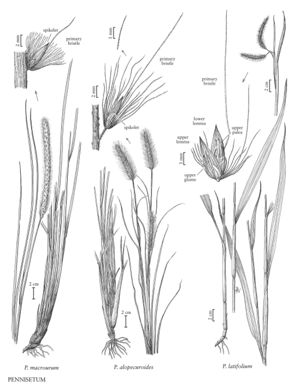Difference between revisions of "Pennisetum alopecuroides"
FNA>Volume Importer |
imported>Volume Importer |
||
| (8 intermediate revisions by 2 users not shown) | |||
| Line 4: | Line 4: | ||
|publications= | |publications= | ||
|common_names=Foxtail fountaingrass | |common_names=Foxtail fountaingrass | ||
| + | |special_status={{Treatment/ID/Special_status | ||
| + | |code=I | ||
| + | |label=Introduced | ||
| + | }} | ||
|basionyms= | |basionyms= | ||
|synonyms= | |synonyms= | ||
| Line 17: | Line 21: | ||
-->{{Treatment/Body | -->{{Treatment/Body | ||
|distribution=Pa.;Ohio;N.C.;N.Y.;Ark.;Ill. | |distribution=Pa.;Ohio;N.C.;N.Y.;Ark.;Ill. | ||
| − | |discussion=<p>Pennisetum alopecuroides is native to southeast Asia. It is frequently grown as an ornamental in the Flora region.</p> | + | |discussion=<p><i>Pennisetum alopecuroides</i> is native to southeast Asia. It is frequently grown as an ornamental in the Flora region.</p> |
|tables= | |tables= | ||
|references= | |references= | ||
| Line 26: | Line 30: | ||
-->{{#Taxon: | -->{{#Taxon: | ||
name=Pennisetum alopecuroides | name=Pennisetum alopecuroides | ||
| − | |||
|authority=(L.) Spreng. | |authority=(L.) Spreng. | ||
|rank=species | |rank=species | ||
| Line 33: | Line 36: | ||
|basionyms= | |basionyms= | ||
|family=Poaceae | |family=Poaceae | ||
| + | |illustrator=Linda A. Vorobik | ||
| + | |illustration copyright=Utah State University | ||
|distribution=Pa.;Ohio;N.C.;N.Y.;Ark.;Ill. | |distribution=Pa.;Ohio;N.C.;N.Y.;Ark.;Ill. | ||
|reference=None | |reference=None | ||
|publication title= | |publication title= | ||
|publication year= | |publication year= | ||
| − | |special status= | + | |special status=Introduced |
| − | |source xml=https:// | + | |source xml=https://bitbucket.org/aafc-mbb/fna-data-curation/src/200273ad09963decb8fc72550212de541d86569d/coarse_grained_fna_xml/V25/V25_1358.xml |
|subfamily=Poaceae subfam. Panicoideae | |subfamily=Poaceae subfam. Panicoideae | ||
|tribe=Poaceae tribe Paniceae | |tribe=Poaceae tribe Paniceae | ||
Latest revision as of 17:56, 11 May 2021
Plants perennial; cespitose. Culms 30-100 cm, erect; nodes glabrous. Sheaths glabrous, margins ciliate; ligules 0.2-0.5 mm, membranous, ciliate; blades (10)30-60 cm long, 2-8(12) mm wide, flat to folded, glabrous, margins ciliate basally. Panicles all terminal, 6-20 cm long, 20-53 mm wide, fully exerted from the sheaths, erect, green to brown, deep purple, or stramineous to creamy-white; rachises terete, with pubescent hairs. Fascicles 9-16 per cm; fascicle axes 1.5-5.6 mm, with a stipelike base of 1-5.6 mm and 1(2) spikelet(s); outer bristles 13-19, 0.8-15.6 mm; inner bristles 7-10, 11.2-30 mm, scabrous; primary bristles 26.7-35 mm, scabrous, usually not noticeably longer than the other bristles. Spikelets 5.5-8.4 mm, sessile or subsessile, glabrous; pedicels to 0.1 mm; lower glumes 0.2-1.4 mm, veinless; upper glumes 2-4.9 mm, to 1/2 as long as the spikelet, 1-5-veined, acute to broadly acute; lower florets sterile; lower lemmas 4.9-8.1 mm, 7-9(10)-veined; lower paleas absent; upper lemmas 5.2-7.6 mm, 5-7-veined, acuminate; anthers 3, 3-4.5 mm. 2n = 18.
Distribution
Pa., Ohio, N.C., N.Y., Ark., Ill.
Discussion
Pennisetum alopecuroides is native to southeast Asia. It is frequently grown as an ornamental in the Flora region.
Selected References
None.
